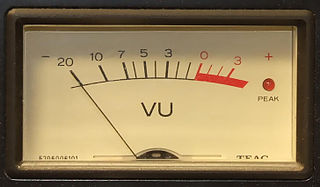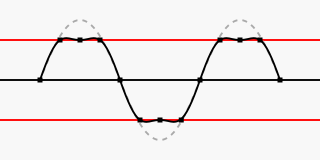
Dynamic range compression (DRC) or simply compression is an audio signal processing operation that reduces the volume of loud sounds or amplifies quiet sounds, thus reducing or compressing an audio signal's dynamic range. Compression is commonly used in sound recording and reproduction, broadcasting, live sound reinforcement and some instrument amplifiers.

Audio system measurements are a means of quantifying system performance. These measurements are made for several purposes. Designers take measurements so that they can specify the performance of a piece of equipment. Maintenance engineers make them to ensure equipment is still working to specification, or to ensure that the cumulative defects of an audio path are within limits considered acceptable. Audio system measurements often accommodate psychoacoustic principles to measure the system in a way that relates to human hearing.

In acoustics, loudness is the subjective perception of sound pressure. More formally, it is defined as the "attribute of auditory sensation in terms of which sounds can be ordered on a scale extending from quiet to loud". The relation of physical attributes of sound to perceived loudness consists of physical, physiological and psychological components. The study of apparent loudness is included in the topic of psychoacoustics and employs methods of psychophysics.
ReplayGain is a proposed technical standard published by David Robinson in 2001 to measure and normalize the perceived loudness of audio in computer audio formats such as MP3 and Ogg Vorbis. It allows media players to normalize loudness for individual tracks or albums. This avoids the common problem of having to manually adjust volume levels between tracks when playing audio files from albums that have been mastered at different loudness levels.

A volume unit (VU) meter or standard volume indicator (SVI) is a device displaying a representation of the signal level in audio equipment.
Audio normalization is the application of a constant amount of gain to an audio recording to bring the amplitude to a target level. Because the same amount of gain is applied across the entire recording, the signal-to-noise ratio and relative dynamics are unchanged. Normalization is one of the functions commonly provided by a digital audio workstation.
In digital and analog audio, headroom refers to the amount by which the signal-handling capabilities of an audio system can exceed a designated nominal level. Headroom can be thought of as a safety zone allowing transient audio peaks to exceed the nominal level without damaging the system or the audio signal, e.g., via clipping. Standards bodies differ in their recommendations for nominal level and headroom.

Decibels relative to full scale is a unit of measurement for amplitude levels in digital systems, such as pulse-code modulation (PCM), which have a defined maximum peak level. The unit is similar to the units dBov and decibels relative to overload (dBO).

A peak programme meter (PPM) is an instrument used in professional audio that indicates the level of an audio signal.

ITU-R 468 is a standard relating to noise measurement, widely used when measuring noise in audio systems. The standard, now referred to as ITU-R BS.468-4, defines a weighting filter curve, together with a quasi-peak rectifier having special characteristics as defined by specified tone-burst tests. It is currently maintained by the International Telecommunication Union who took it over from the CCIR.
In acoustics, noise measurement can be for the purpose of measuring environmental noise or measuring noise in the workplace. Applications include monitoring of construction sites, aircraft noise, road traffic noise, entertainment venues and neighborhood noise. One of the definitions of noise covers all "unwanted sounds". When sound levels reach a high enough intensity, the sound, whether it is wanted or unwanted, may be damaging to hearing. Environmental noise monitoring is the measurement of noise in an outdoor environment caused by transport, industry and recreational activities. The laws and limits governing environmental noise monitoring differ from country to country.

The loudness war is a trend of increasing audio levels in recorded music, which reduces audio fidelity and—according to many critics—listener enjoyment. Increasing loudness was first reported as early as the 1940s, with respect to mastering practices for 7-inch singles. The maximum peak level of analog recordings such as these is limited by varying specifications of electronic equipment along the chain from source to listener, including vinyl and Compact Cassette players. The issue garnered renewed attention starting in the 1990s with the introduction of digital signal processing capable of producing further loudness increases.
Audio noise measurement is a process carried out to assess the quality of audio equipment, such as the kind used in recording studios, broadcast engineering, and in-home high fidelity.
The alignment level in an audio signal chain or on an audio recording is a defined anchor point that represents a reasonable or typical level.
Perceptual Evaluation of Audio Quality (PEAQ) is a standardized algorithm for objectively measuring perceived audio quality, developed in 1994–1998 by a joint venture of experts within Task Group 6Q of the International Telecommunication Union's Radiocommunication Sector (ITU-R). It was originally released as ITU-R Recommendation BS.1387 in 1998 and last updated in 2023. It utilizes software to simulate perceptual properties of the human ear and then integrates multiple model output variables into a single metric.
Dialnorm is the metadata parameter that controls playback gain within the Dolby Laboratories Dolby Digital (AC-3) audio compression system. Dialnorm stands for dialog normalization. Dialnorm is an integer value with range 1 to 31 corresponding to a playback gain of -30 to 0 dB (unity) respectively. Higher values afford more headroom and are appropriate for dynamic material such as an action film.
EBU R 128 is a recommendation for loudness normalisation and maximum level of audio signals. It is primarily followed during audio mixing of television and radio programmes and adopted by broadcasters to measure and control programme loudness. It was first issued by the European Broadcasting Union in August 2010 and most recently revised in August 2020.
Loudness, K-weighted, relative to full scale (LKFS) is a standard loudness measurement unit used for audio normalization in broadcast television systems and other video and music streaming services.
Linear Acoustic is an American company based in Lancaster, Pennsylvania that develops technology and manufacturers equipment used by television stations, cable television and satellite television services providers, post-production facilities and other content services providers to control, measure, manage and monitor multi-channel digital audio. The company has been especially active in areas related to automated upmixing and downmixing of multichannel broadcast audio, and with issues related to relative loudness of broadcast audio.

The EBU colour bars are a television test card used to check if a video signal has been altered by recording or transmission, and what adjustments must be made to bring it back to specification. It is also used for setting a television monitor or receiver to reproduce chrominance and luminance information correctly. The EBU bars are most commonly shown arranged side-by-side in a vertical manner, though some broadcasters – such as TVP in Poland, and Gabon Télévision in Gabon – were known to have aired a horizontal version of the EBU bars.








